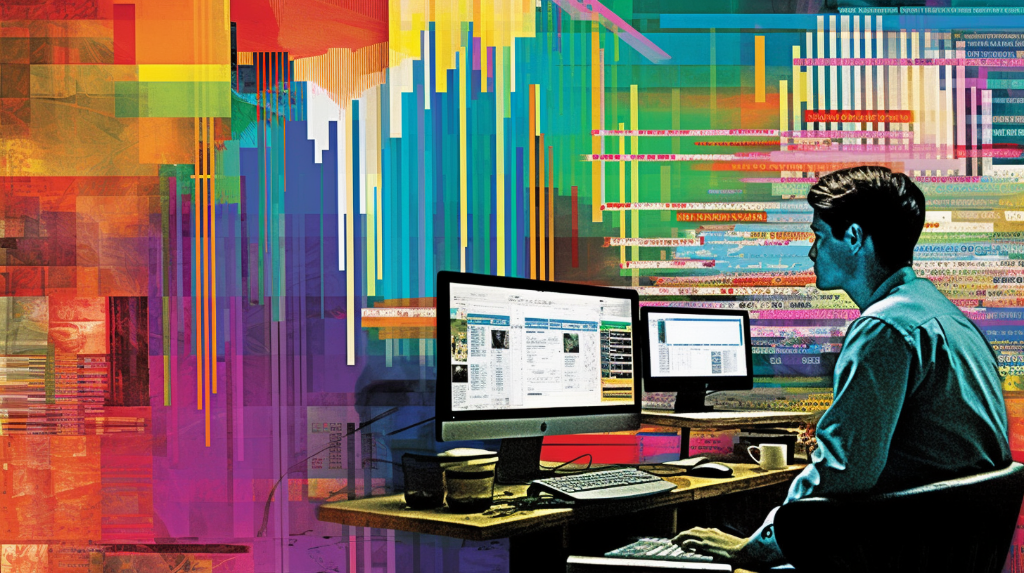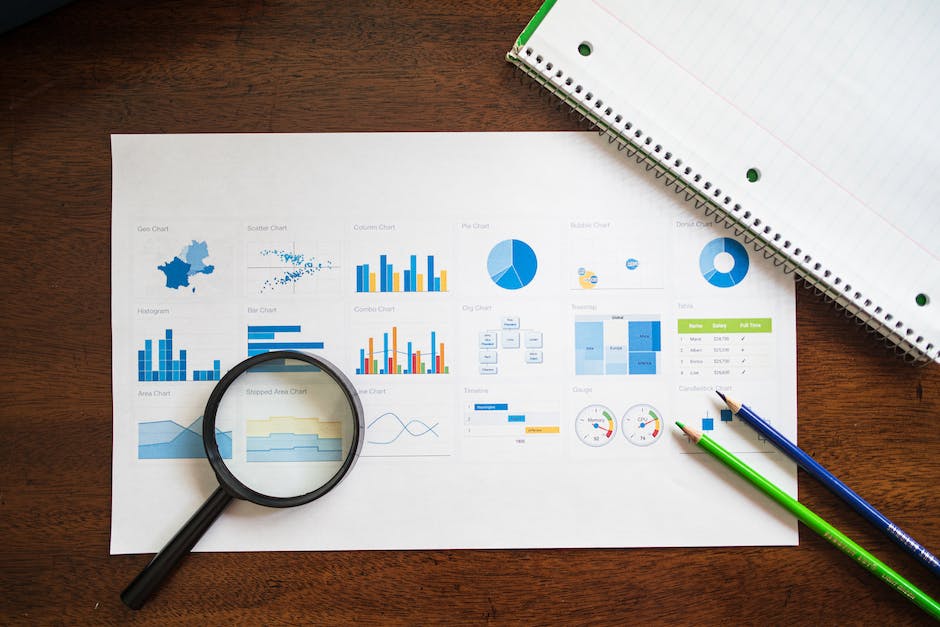Data visualization is a crucial aspect of our tech-driven world today. It is a method of interpreting and understanding complex data by translating it into visual context. The importance of data visualization cannot be overstated, especially in the realm of tech jobs where it is often necessary to analyze and comprehend large volumes of complex data. In this blog post, we will take a journey through the world of data visualization, exploring its various types and uses.

Understanding the Basics of Data Visualization
Data visualization has a rich history that dates back centuries, but it has taken on unprecedented importance in the digital age. It plays a pivotal role in the decision-making processes in tech jobs, where it helps to transform raw, unprocessed data into meaningful insights.
By visualizing data, we can detect patterns, trends, and outliers that might otherwise remain hidden in the text-based data. This enables faster decision-making, better data analysis, and increased understanding of the information presented.
Core Principles of Data Visualization
There are fundamental principles that govern the process of data visualization. First and foremost, simplicity is key. The goal of data visualization is to simplify complex data into a format that can be easily understood.
Clarity is another crucial principle. It is essential for the visualization to clearly convey the information it represents. This involves choosing the right visualization type, using appropriate colors, and ensuring that the visualization is not cluttered or confusing.
Honesty is also a guiding principle in data visualization. The visualization should accurately represent the data, without any distortions or misrepresentations that could mislead the viewer. Transparency about the source and nature of the data is also important.
Lastly, effective data visualization should make complex data easily understandable. This involves breaking down complicated concepts into simpler visual representations that can be easily interpreted by the viewer.
Broad Categories of Data Visualization
When we talk about data visualization, we can generally categorize the types into broad groups. This categorization not only helps in understanding the nature of the visual representation but also aids in deciding which type would be best suited for a particular set of data or a specific purpose.
Static vs. Interactive Visualizations
One of the basic divisions in data visualization types is between static and interactive visualizations. Static visualizations, as the name suggests, are fixed visual representations of data. They do not change or interact with the user. Examples of static visualizations include bar graphs, line charts and pie charts. They are typically used when the data and the message are straightforward and do not require user interaction.
On the other hand, interactive visualizations offer the user the ability to manipulate the view and explore the data in a more detailed and personalized way. This could involve zooming in and out, filtering subsets of data, or clicking elements to reveal more information. Interactive visualizations are particularly useful when the data is complex, or the user needs to be able to customize the view to their needs.
2D vs. 3D Visualizations
Another way to categorize data visualizations is by their dimensionality: 2D or 3D. Two-dimensional visualizations have length and width, but no depth. They are simple, clear, and easy to understand. Bar charts, line graphs, and scatter plots are all examples of 2D visualizations.
In contrast, 3D visualizations add a depth dimension to the representation. This allows for the display of more complex data or multiple data sets in one visualization. However, 3D visualizations can be harder to read and interpret than their 2D counterparts, and should be used judiciously. They are often used when the data has a natural three-dimensional aspect, such as in architectural or aviation designs.
Tools and Software for Data Visualization
There are numerous tools and software available today that make data visualization more accessible and effective. Choosing the right tool depends on various factors such as the complexity of your data, the type of visualization you want to create, and your technical skills.
One popular tool is Tableau, which offers a wide range of visualization options in a user-friendly interface. It is well-suited to creating complex, interactive visualizations and dashboards.
Power BI, a Microsoft product, is another versatile tool for data visualization. It integrates seamlessly with other Microsoft products and offers a good balance of simplicity and functionality.
For those with coding skills, Python libraries like Matplotlib and Seaborn offer even more flexibility and control over data visualization. These libraries, while requiring a higher level of technical skill, allow for the creation of highly customized visualizations.
Simple and Common Visualization Types
Let’s begin with the basic building blocks of data visualization. These are the types that you’ve likely encountered in school or in various reports and presentations. They are simple, straightforward, but incredibly effective when used correctly. So, what are these types?
- Bar Graphs: These are used to compare quantities of different categories. They can be horizontal or vertical.
- Pie Charts: These are used to show proportions of a whole. They effectively communicate a percentage or proportional data.
- Line Graphs: These are used to show change over time. They are ideal for showing trends.
- Scatter Plots: These are used to show the relationship between two numerical values.
- Area Charts: Similar to line graphs, but they also fill in the area below the line. This can be useful to visualize volume.
These are just a few examples, but they represent some of the most commonly used types of data visualization.
Complex Visualization Types
As we dive deeper into the field of data visualization, we encounter more complex types. These visualizations can handle multiple variables, allowing us to uncover patterns and insights that simple visualizations might not reveal. Intriguing, isn’t it?
Let’s explore some of these complex visualization types:
- Heat Maps: These use color gradients to represent data values. They’re great for spotting patterns and clusters in large data sets.
- Treemaps: These are used to display hierarchical data as a set of nested rectangles. Each branch of the tree is given a rectangle, which is then tiled with smaller rectangles representing sub-branches.
- Geospatial Maps: These are used to represent data associated with geographical locations. They’re useful in fields like logistics, urban planning, and environmental studies.
Interactive Visualization Types
How about visualizations that don’t just display data, but also allow users to interact with it? Interactive visualizations bring data to life, allowing users to drill down into the specifics, filter to view particular segments, or even manipulate the data in real-time. Sounds impressive, right?
Let’s list some of these interactive visualization types along with scenarios they are typically used in:
| Type | Description | Typical Use Case |
|---|---|---|
| Dashboards | A collection of visualizations, reports, and other data that provides a consolidated view of business data. | Used by businesses to track key performance indicators (KPIs) and other metrics. |
| Filters | Allow users to focus on a specific subset of data. | Used in reports and dashboards to provide custom views of data. |
| Drill-Downs | Allow users to view data in more detail. | Used in business intelligence to analyze detailed aspects of data. |
Remember, the best type of visualization depends on the nature of your data and the story you want to tell. So, always consider these factors when choosing a visualization type.

Best Practices for Data Visualization
Creating a successful data visualization is not just about choosing the right type or having the right tools. It’s also about adhering to a set of best practices that ensure your visualization is effective, clear, and impactful. Let’s explore some of these.
Firstly, simplicity is key. Your visualization should be as straightforward as possible, ensuring that even someone with no prior knowledge can understand the information you’re trying to convey. Too much complexity can lead to confusion and misinterpretation.
Secondly, always ensure your visualizations are honest and accurately represent the data. Misleading visuals can lead to incorrect conclusions and damage your credibility.
Lastly, consider your audience. Different groups may prefer different types of visualizations. Tailoring your visuals to your audience can make your data more engaging and easier to understand.
Future Trends in Data Visualization
Data visualization is a rapidly evolving field, and staying updated with the latest trends is crucial. As we move forward, we can expect to see more interactive visualizations that allow users to explore data in real time, adding a dynamic component to data analysis.
Moreover, with the rise of Big Data and Machine Learning, visualizations that can handle large datasets and complex algorithms are becoming increasingly important. This means that proficiency in advanced tools and libraries will be a valuable skill in the tech job market.
Augmented Reality (AR) and Virtual Reality (VR) are also making their way into data visualization, providing immersive experiences that allow for more intuitive understanding of data. Isn’t it exciting to think about the possibilities?
Wrapping Up
In today’s data-driven world, understanding different types of data visualization is not just a nice skill to have – it’s a necessity, especially for those looking to secure a job in the tech field. The ability to present complex data in an easily digestible format is a skill that employers value greatly.
So, what are you waiting for? Start exploring different types of data visualizations, practice using different tools, and keep yourself updated with the latest trends. Remember, practice makes perfect, and every step you take is one step closer to becoming a data visualization expert.
